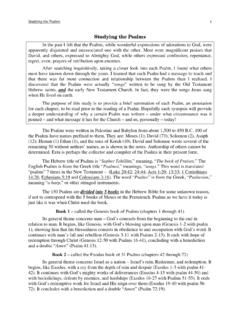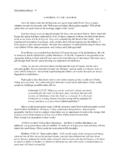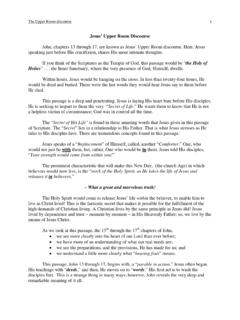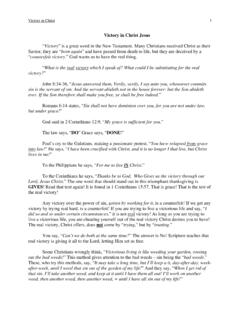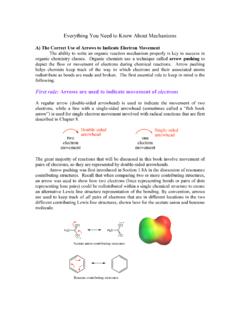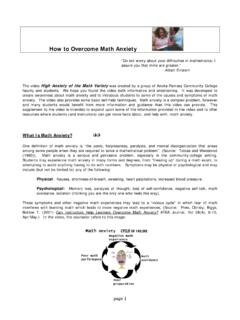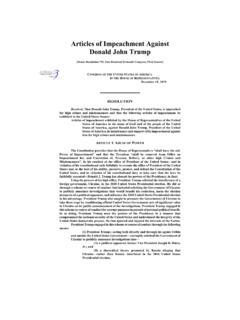Transcription of Law of First mention - NetBibleStudy.com
1 1 1. The Biblical Law of First mention One of the most remarkable evidences of Biblical unity is the internal consistency, and no where is this internal evidence more strikingly evident than in a phenomenon which students of the Bible refer to as "The Law of First mention ," which simply means that the very First time any important word is mentioned in the Bible [usually, of course, is in Genesis, the First book of the Bible] Scripture gives that word its most complete, and accurate, meaning to not only serve as a "key" in understanding the word's Biblical concept, but to also provide a foundation for its fuller development in later parts of the Bible.
2 Examples of this phenomenon are as follows: Word First mention Word First mention Light Genesis 1:3 Vision Genesis 15:1 Blood Genesis 4:10 Shield Genesis 15:1 Grace Genesis 6:8 Reward Genesis 15:1 Just [Righteous] Genesis 6:9 "I Am" Genesis 15:1 Perfect Genesis 6:9 Word Genesis 15:1 Atonement [Pitch] Genesis 6:14 Imputed {Counted] Genesis 15:6 Covenant Genesis 6:18 Righteousness Genesis 16:6 Altar Genesis 8:20 Angel of the Lord Genesis 16:7 Shed [Pour out] Genesis 9:6 Worship [bow down] Genesis 18:2 Wine Genesis 9:21 Mercy Genesis 19:16 Drunken Genesis 12:15 Fire Genesis 19:24 Praise [Command] Genesis 12:15 Obey Genesis 22:18 Peace [Salem] Genesis 14:18 Sow Genesis 26:12 Tithes Genesis 14:20 Salvation Genesis 49.}
3 18 These examples above are only a few of the many, throughout God's Word, that demonstrate the Biblical phenomenon of this "Law of First mention " and, although we do not have the time to expound on these example in this lesson, nonetheless, we can see from them that they do, in fact, give clear, and unmistakable, testimony to the reality that the whole Bible, from Genesis to Revelation, has One Great Author, because, this phenomenon of the 2 Law of First mention is not only completely beyond the reach of any possible human contrivance, but, also its recurring occurrence throughout Scripture is too striking to be attributed to mere chance, hence the only explanation for this phenomenon is, as 2 Peter 1:21 tells us, that, "Holy men of God spake as they are moved [controlled] by the Holy Spirit.
4 " 2. The Biblical Law of the Numerical Structure of Scripture Another phenomenon of the Bible, which can only be understood in the light of Divine inspiration, is the absoluteness of its mathematical structure, a mathematical structure which has been the subject of many studies. One of these studies was done by a converted Russian Nihilist and Harvard scholar, Ivon Panin, who, being a mathematician, spent fifty years studying the subject of Bible numerics. Many other competent scholars have studied, and consequently, written works on, the subject of Biblical numerology. Some of these works include: Browne's, "Ordo Saeculoreum" Grant's, "Numerical Bible" Bullinger's, "Numbers in Scriptures" and John J.
5 Davis' Biblical Numerology One aspect of Biblical numerology is the fact that every letter of the Hebrew and Greek manuscripts is numbered and occupies its own special place in the order of the total number of letters in the Bible. Every word, phrase, sentence, and paragraph, has a definite numerical sum and the whole text of the Bible, from Genesis to Revelation, has sequences, combinations, ratios, etc., that follow a uniform design. In his study of the ancient Biblical texts, Dr. Panin took a given subject, such as the genealogy of Christ as found in Matthew 1:1-17 .. or a book of the Bible as a whole.
6 Or the Bible in its entirety, and he was able to illustrate the following phenomena: The number of words in the vocabulary are divisible by seven! The number of words beginning with a vowel are divisible by seven! The number of words beginning with a consonant are divisible by seven! The number letters in the vocabulary are divisible by seven! [And, of these letters, both those which are vowels, and those which are consonants, are divisible by seven! The number of words in the vocabulary which occur more than once is divisible by seven, and, likewise, the number of words in the vocabulary which occur only once is also divisible by seven!]
7 The number of words which occur in more than one form is divisible by seven, and, likewise, the number of words in the vocabulary which occur in only one form is also divisible by seven! The number of proper names divisible by seven! The number of male names are divisible by seven! The number of female names are divisible by seven! The number of words beginning with each of the letters os the alphabet is divisible by seven! 3 The Bible is written in two languages: The Old Testament is written in Hebrew .. [a few chapters are written in Chaldee which, for numerical purposes, is the same as Hebrew].
8 And the New Testament is written in Greek. Both these languages have the peculiarity of having no separate symbols for numbers which correspond to our modern Arabic figures - 1, 2, 3, 4, 5, 6, 7, 9, 0 - and, because they do not have separate numbers, what these languages do is make use of the letters of their alphabet, so that each Hebrew and Greek letter stands also for a certain number, which is called the "numeric value" of the letter. As each word consists of letters, the numeric value of a word is the sum of the numeric values of its letter. The numeric value of a sentence, paragraph, chapter, book, volume, or library, is the sum of the numeric values of the words of which these consist.
9 4 While it was by means of these numeric values that the Greeks and Hebrews performed all their numeric operations, when we analyze the numeric scheme of Scripture, we find that besides its "numeric value," each letter, in both the Hebrew and Greek language, has what is called a "Place Value," and the "Place Value" of a letter in the Scripture, whether Hebrew or Greek, is the number of the place the letter occupies in the alphabet. Accordingly, in the Hebrew, the Place Values and the Numeric Values are only the same for the First ten letters, while in the Greek, the Place Values and the Numeric Values are only the same for the First five letters.
10 This being true, while the Place Value of the eleventh Hebrew letter is 11, its Numeric Value is not 11, but, rather is 400. The same holds true for the Greek alphabet, while the Place Value of the sixth Greek letter is 6, its Numeric Value is not 6, but, rather, 7. The full value of a Hebrew or Greek letter, or word, is the sum of its "Numeric" and its "Place" value, thus the full value of the word for "Jesus" in the Greek, is 975, of which the Numeric Value is 888, and the Place Value is 87. Other features which Panin's study brought to light is the fact that the Numerical Value of the vocabulary, the various alphabetical groups of words, and the various forms in which the words occur, are all divisible by seven!
